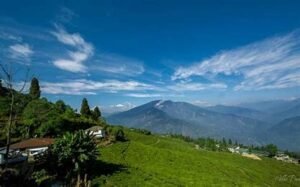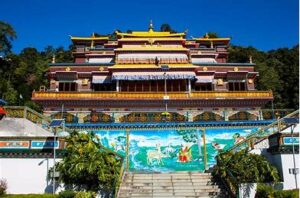Pobitora Wildlife Sanctuary is located in Assam, India, approximately 48 kilometers east of the state’s largest city, Guwahati. It is renowned for its dense population of the Indian rhinoceros (Rhinoceros unicornis). The sanctuary is important not only because of its unique wildlife but also due to its conservation efforts in protecting endangered species. It stands out in the region for providing a habitat where these rhinos thrive, offering a significant contrast to other wildlife sanctuaries in India, which are often larger and more well-known.
Historical Background
Established in 1987, Pobitora Wildlife Sanctuary was created as a conservation area to protect the Indian rhinoceros, which was facing a declining population in the wild. Over the years, the sanctuary has played a critical role in the recovery of the rhino population in the region. Historically, the area was part of the Kaziranga National Park’s broader rhino conservation strategy but was set aside to create a more focused effort on this species in particular. Today, Pobitora stands as a testament to the success of targeted conservation initiatives, contributing to the overall protection of biodiversity in Assam.
Geography and Landscape
Pobitora Wildlife Sanctuary covers an area of 38.8 square kilometers, located on the southern banks of the Brahmaputra River. Its landscape consists of a mix of wetlands, grasslands, and small hills, which provide an ideal environment for a variety of species. The sanctuary’s geographical features include marshy areas that are rich in flora and fauna, making it a vital site for many wildlife species, including aquatic birds and amphibians. The climate in Pobitora is tropical, characterized by hot summers and mild winters, which influences both the flora and fauna found in the sanctuary.
Culture and Traditions
While Pobitora is primarily known for its wildlife, it is also surrounded by several indigenous communities, including the Mishing and Bodo tribes. These communities have lived in the area for generations and maintain cultural traditions that are deeply connected to the natural environment. Their practices include sustainable farming and fishing, reflecting their respect for the ecosystems around them. Although wildlife conservation has become a focal point, the traditional knowledge and practices of these communities contribute to the region’s overall ecological balance.
Local People and Community
The local population surrounding Pobitora consists of various ethnic groups, including the Mishing and Bodo tribes, who are primarily engaged in agriculture and fishing. The lifestyle of these communities is closely tied to the land and river, with farming practices that have been passed down through generations. In terms of notable figures, there aren’t internationally renowned personalities directly associated with Pobitora. However, local conservationists and environmental activists have played an important role in advocating for the preservation of the sanctuary’s unique wildlife.
Key Attractions and Activities
Pobitora Wildlife Sanctuary is best known for its dense population of Indian rhinoceroses. The sanctuary offers opportunities for wildlife observation, particularly of the rhinoceros in their natural habitat. In addition to rhinos, Pobitora is home to other species such as wild buffalo, elephants, and a variety of birds. The sanctuary is especially significant for birdwatchers, as it hosts species like the endangered Greater Adjutant Stork. Its wetlands and grasslands provide the perfect environment for these diverse species. Educational programs on wildlife conservation and ecology are also available for visitors to learn about the ecosystem in depth.
Food and Cuisine
While the focus of Pobitora is on wildlife and conservation, the surrounding region is known for its rich Assamese cuisine. Dishes such as masor tenga (a sour fish curry) and pitha (rice cakes) are staples of the local diet. Traditional Assamese food is known for its use of local ingredients, with an emphasis on rice, fish, and seasonal vegetables. In addition to these, khar, a dish made with raw papaya and pulses, holds cultural significance and is frequently consumed during festivals. This culinary diversity is a reflection of the region’s rich agricultural practices and reliance on local resources.
Festivals and Celebrations
Pobitora shares in the cultural traditions of Assam, which include several major festivals throughout the year. One of the most important is Bihu, the Assamese New Year, which marks the arrival of spring. This festival is celebrated with traditional music, dance, and feasting. Magh Bihu, a harvest festival, is also a significant occasion, during which the community celebrates the agricultural cycle. These festivals reflect the close relationship between the people of Assam and their natural environment, including the seasonal changes that influence both their agricultural practices and wildlife.
Myths, Legends, and Stories of Pobitora
Like many regions rich in cultural and natural history, Pobitora is surrounded by local myths and folklore. One such legend is the belief that rhinos in the area are sacred creatures, with some communities considering them protectors of the land. These myths, which have been passed down through generations, underscore the deep respect that local tribes have for wildlife and the environment. Such stories help in maintaining the connection between the people and the land they inhabit, reinforcing the importance of conservation.
Conservation and Sustainability
Pobitora is at the forefront of wildlife conservation in Assam, particularly concerning the Indian rhinoceros. Conservation efforts focus on protecting the sanctuary’s biodiversity, preventing poaching, and ensuring the safe management of natural resources. Collaboration with local communities is central to these efforts, as their support is crucial in maintaining the delicate balance between human activities and wildlife preservation. The sanctuary also faces challenges such as climate change and the potential for over-tourism, which may strain the ecosystem. Sustainable practices are essential to ensure the long-term preservation of Pobitora’s natural heritage.
Individuals who visit Pobitora Wildlife Sanctuary often express admiration for the peaceful coexistence of wildlife and the natural environment. One common observation is the serenity of witnessing wildlife in their natural habitats, with the rhinos being a particularly significant attraction. These personal experiences underscore the sanctuary’s role as an educational resource, providing an opportunity to observe and learn about endangered species and their ecosystems.
Pobitora Wildlife Sanctuary is an integral part of Northeast India’s diverse ecological and cultural landscape. It plays a crucial role in preserving not only the Indian rhinoceros but also many other species that are endemic to the region. The sanctuary is reflective of the broader environmental issues and cultural richness found throughout Northeast India. As such, Pobitora contributes to the region’s identity, offering insight into both the natural and cultural heritage of the area.
Way Forward
Pobitora Wildlife Sanctuary is poised to expand its role in conservation and eco-tourism. Future initiatives are focused on enhancing the sanctuary’s infrastructure while maintaining its commitment to sustainability. Increasing community involvement in conservation efforts and improving educational outreach are also priorities. By developing a more sustainable tourism model, Pobitora aims to protect its unique biodiversity and provide educational opportunities for future generations.
Conclusion
Pobitora Wildlife Sanctuary serves as a vital site for wildlife conservation and offers valuable insights into the biodiversity of Assam and Northeast India. Its dense rhino population, rich cultural context, and ongoing conservation efforts make it an important area of study for both environmentalists and those interested in indigenous cultures. By understanding and supporting the sanctuary’s work, we can ensure that Pobitora continues to thrive as a protected haven for wildlife and a source of cultural and ecological knowledge.




